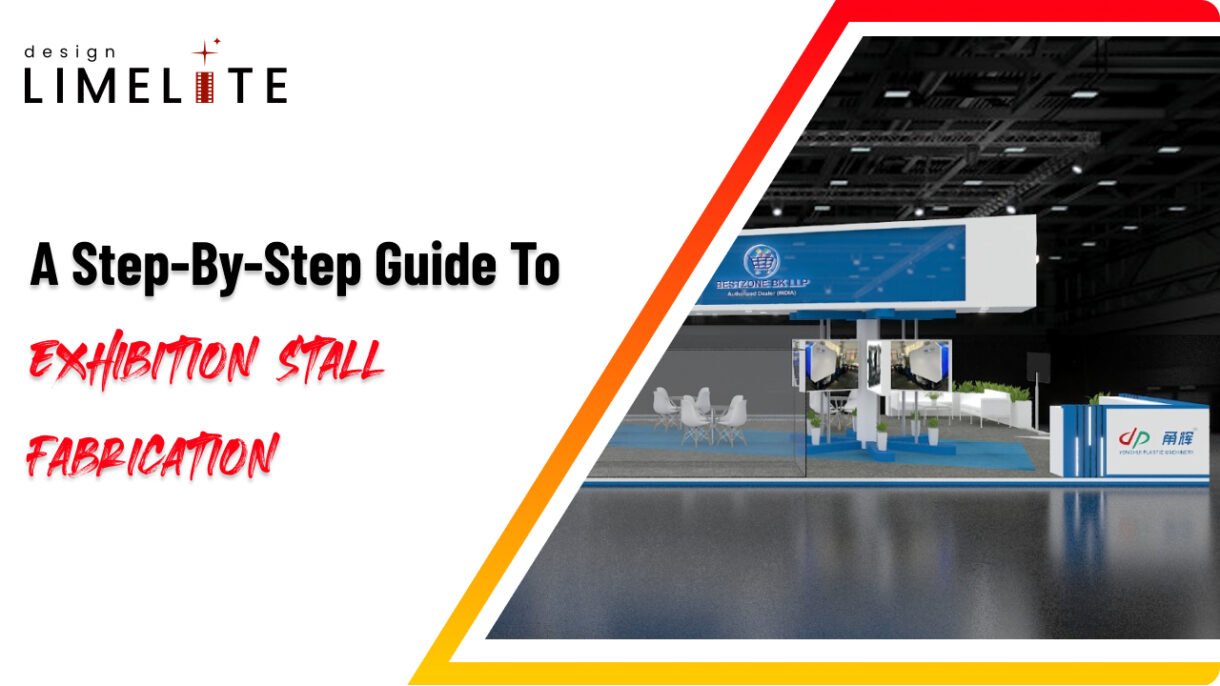In the busy world of industrial expos and trade shows, the first impression is everything. Your exhibition stall is one of the touchpoints for potential clients and partners. That is when exhibition stall fabrication plays an important role.
Exhibition stall fabrication is a process of designing and constructing a branded booth that is customized for exhibitions and events. The process includes everything, from layout planning and material selection to structural build, lighting, and finishing. So, your booth looks both aesthetic and functional.
In a high-stakes environment, visibility can make or break opportunities. Therefore, investing in professional fabrication is important, as it is more than just a simple decoration now. You can transform your event presence into a strategic brand and grab attention as well as increase engagement.
If you want to showcase innovation and generate leads by launching new products, a well-designed stall can help you have lasting connections.
In this blog, you can go through an ultimate guide to designing and fabricating an exhibition stall. So let’s get started.
A Complete Step-by-Step Exhibition Stall Design and Fabrication Guide

Step 1: Define Objectives and Budget
Before starting stall designing make it clear what you want to achieve at the exhibition. It helps to make every decision.
What’s Your Goal?
Ask yourself these questions:
- Are you launching a product and want maximum visibility?
- Are you looking to generate brand awareness with eye-catching designs?
- Are you trying to create leads or connect with industry professionals?
- Do you want to deliver interactive demos or presentations?
When you know your purpose, you can prioritize design elements like,
- Layout flow
- Digital displays
- Engagement zones
Set a Realistic Budget
Once you are all set with your goals, you can outline a budget.
- Cover the costs for,
- Design
- Fabrication
- Logistics
- Rentals
- Staffing
- Decide on what is important vs. what is good to have
- LED walls vs. printed banners
- Modular structures vs. custom builds
- Consider the costs for,
- Branding materials
- Safety compliance
- On-site services
A clear budget with clear goals helps to avoid extra expenses and ensure a successful exhibition stall fabrication project.
Step 2: Conceptual Design
In this step, you can shape your stall’s personality before starting any physical work.
Build Around Your Brand
- You can make your stall easily recognizable by using your brand
- Colors
- Logo
- Fonts
- You can bring your brand story into visual elements such as,
- Panels
- Graphics
- Lighting
- You need to ensure consistency across
- Signage
- Digital displays
- Product zones
♀️ Focus on Visitor Experience
- You can design paths that feel natural and guide visitors in different sections.
- You need to place highlights (i.e., demo stations, product shelves) in high-impact zones.
- You can include resting or interaction points to boost engagement.
- You can keep the layout open, accessible, and welcoming.
️ Visual Planning Tools
- You can sketch or use 3D rendering software to preview various ideas.
- You should test
- The color combination
- Furniture placement
- Structural accents
- You can share mockups with stakeholders or fabricators to get feedback and refinements.
A thoughtfully designed exhibition stall can be a mixture of beauty and purpose. It attracts attention and delivers your brand message with high impact.
Step 3: Choose the Right Materials
Choosing the right materials is like selecting the bones and skin of your stall. It directly affects the look of your stall, the process of set up, and how long it lasts.
Lightweight Materials for Easy Setup
- If you want a quick installation, you should go for
- Aluminum frames
- PVC panels
- They are easy to transport, budget-friendly, and suitable for one-time use or short-term events.
- When you have limited setup time for an indoor exhibition, it is the best option to choose.
Durable Materials for Long-Term Use
- If you want materials for long-term use and need better support, you should go for
- Laminated MDF boards
- Steel structures
- They offer the best support and hold up well for different events. It also maintains a premium finish for a long time.
- These materials are suitable for brands that want to invest in a customized setup for longer use.
️ Consider the Environment
- If the venue is outdoors, it requires weather-resistant materials.
- Think about,
- Humidity
- Temperature
- Exposure to sunlight
- According to your needs, you can choose
- Waterproof coatings
- Anti-rust structures
- UV-resistant finishes
Choosing the right combination of materials ensures that your exhibition stall design and fabrication address your needs and goals.
️ Step 4: Fabrication Process – Bringing Your Stall to Life
After successful planning and design, it is now time to build your exhibition stall into real life. This step includes creating, installing, and finishing everything that helps your stall work smoothly.
Build the Structure
- Skilled teams start with
- Woodwork
- Metal framing
- Core construction
- You should focus on walls, counters, and different support elements that need to be shaped according to the final design.
- Check on signboards and branded features are carefully installed for better visibility.
Add Functional Components
- Install lighting systems to highlight important areas and generate an aura.
- Install audio-visual equipment like,
- Screens
- Speakers
- Digital displays
- To attract visitors, add interactive elements such as
- Touchscreens
- Demo zones
- Product shelves
Final Touch for Polish
- Add flooring, furniture, and branding graphics according to your theme.
- Check thoroughly to ensure everything is working and fits well.
- Clean and prepare the space for the event.
With expert support from an experienced exhibition stall fabrication team, your design reflects your brand and delights your client.
Tips for Effective Exhibition Stall Design and Fabrication

♂️ Optimize Space for Traffic Flow
- Create paths that guide visitors from the entrance to important areas, such as demonstrations or product displays.
- Maintain proper space and make it trouble-free, which helps visitors move easily.
- Use zoning to separate
- Demo areas
- Seating
- Product showcases
A layout that is organized properly is important for successful exhibition stall design and fabrication.
Use Visual Story Telling
- Deliver your brand message using
- Graphics
- Structure
- Lighting
- Show a clear narrative: problem → solution → benefit → action
- In your stall, you can add
- Digital screens
- Product visuals
- Live demonstration
When your stall design tells a story, it will create remarkable experiences for your potential clients.
Align Design with Branding
- In all your visuals, you can use your brand’s signature
- Colors
- Fonts
- Voice
- Place your logo and tagline where people can easily see them to highlight your brand.
- Add brand values into design themes such as,
- Sustainability
- Innovation
- Luxury
A visibly connecting look makes sure your exhibition stall design and fabrication build trust among your clients.
Common Mistakes to Avoid in Exhibition Stall Fabrication

When you avoid these common mistakes, your exhibition stall design and fabrication perform well and deliver a strong brand experience.
Overcomplicating the Design
- When you use too many elements, it can confuse your visitors and spoil your message.
- Your stall looks messy when you use many
- Signage
- Clashing colors
- Non-functional decor
You should keep the stall design clean and purposeful to showcase what is important.
♀️ Ignoring Visitor Interaction Zones
- You miss out on engagement if your stall lacks space for
- Demos
- Meetings
- Product exploration
- Without clear areas for communication, visitors may just pass by without stopping.
You should design interactive zones where visitors can touch, try, and learn about your offerings.
⏰ Last-Minute Fabrication Pitfalls
- Finishing the stall in a hurry can cause
- Poor finishing
- Layout issues
- Safety risks
- Delays can leave your stall unfinished and decrease the time you have to showcase it at the event.
You should coordinate with the fabrication team in advance and plan accordingly, as well as add buffer time.
Conclusion
Creating a successful exhibition stall needs thoughtful planning with smart design and a well-prepared execution in real life. Every step of the process is important to represent your brand on the exhibition floor.
When you plan well, exhibition stall fabrication turns your ideas into an appealing space. It captures attention and increases the chances of interaction with potential clients. You can easily convey your brand message to them.
To achieve a great result, it is important to work with experienced stall fabricators like Design LimeLite. They understand creative vision as well as the technical needs. With their expertise, you can make sure that everything works properly, starting from structural safety to branding components.
Source: https://www.designlimelite.com/a-step-by-step-guide-to-exhibition-stall-fabrication/

❓ Frequently Asked Questions (FAQs)
How long does exhibition stall fabrication take?
The timeline depends on the design complexity and customization.
- Standard stalls may take 7–10 days.
- Customization with advanced features may take 2–4 weeks.
- Delivery will be affected by factors like
- Material availability
- Approval cycles
- Last-minute changes
If you coordinate with your exhibition stall fabrication team earlier, it ensures an on-time installation.
What materials are best for stall construction?
The type of material depends on your budget, usage, and event type.
- Aluminium and PVC: They are lightweight and easy to install for short-term use.
- Laminated MDF and steel: They are long-lasting and visually premium for repeated setups.
- Fabric prints and modular panels: They are the best option for customized branding with portability.
When you choose the right materials, it ensures your exhibition stall design and fabrication stay visually appealing and structurally reliable.
Can stalls be reused across events?
Yes, if designed thoughtfully.
- Modular stalls with detachable panels are perfect for reuse.
- Reinforced structures hold up across multiple exhibitions.
- Choose neutral base designs that can be easily rebranded per event.
When you invest in reusable stalls, it decreases future expenses and increases productivity.



